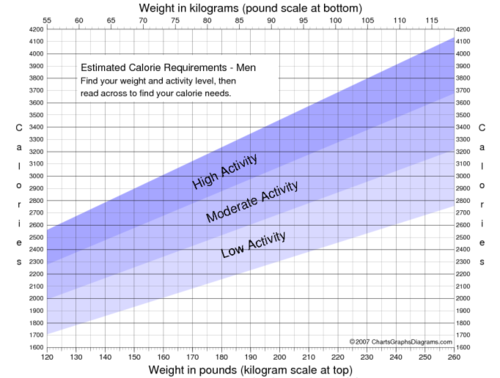For endurance athletes, consuming enough calories (and calories from the right foods) is important to achieve optimal athletic performance. Many endurance athletes are exercising at a level that far exceeds the ‘Active’ description in the 2010 Dietary Guidelines for Americans of ‘walking more than 3 miles per day at 3 to 4 miles per hour, in addition to the light physical activity associated with typical day-to-day life.’ If you read my last post and thought, ‘wow, my activity is well above the level described here!’, then you should probably read on.
Estimating energy needs for athletes who alternate between periods of intense training, maintenance and rest is complex. There are several different methods that can be used to approximate energy needs, while keeping in mind that there is no precise formula. For instance, athletes can use the simplified tables shown below for a basic picture of how energy consumption should rise and fall with activity level.


Another way to gauge the adequacy of your caloric intake is to track your body weight periodically — about every two weeks. Note that this is also not a perfect system, because your weight will fluctuate. But if you see a sustained dip or jump in your weight over a month or two, adjust your caloric intake up or down accordingly.
It is important to pay attention to the content of your diet in order to build lean muscle mass, repair damaged tissues, and sustain energy levels. Follow this consolidated guidance to make sure you’re not only meeting your energy needs, but also nourishing your body correctly to prevent injury and maximize performance. (Your customized food basket created by Inside Tracker can help with this!)
Carbohydrates
During the days leading up to an athletic event, aim for close to 70 percent of your calories to come from carbohydrates. Carbohydrates (typically consumed in breads, pasta, fruits, vegetables, cereals and potatoes) are stored as glucose in your bloodstream and glycogen in your muscles and liver. They provide energy for working muscles, fuel for the central nervous system, enable fat metabolism, and prevent protein from being used for energy. They also yield more energy per unit of oxygen consumed than fats, which becomes important when considering that oxygen often is the limiting factor in long duration events.
For light training days (moderate duration and low intensity), consume about 2.3–3.2 grams of carbs per pound (5–7 grams per kg) body weight. For light-to-moderate workouts, a high-carb diet will usually reload your muscle glycogen stores within about 24 hours. To start the recovery process, consume 0.5 grams of carbs per pound (1.1 grams per kg) body weight within a half hour after exercise. On heavy training days, consume 3.2–4.5 grams of carbs per pound (7–10 grams per kg) body weight.Fat
Fat has gotten an unfortunate reputation during the last several decades, but it is an essential component of an athlete’s diet. When you’re exercising moderately, about half of the total energy expenditure comes from free fatty acid metabolism. For workouts that last more than an hour, your body may actually use mostly fats for energy. Trained athletes use fat for energy more quickly than untrained athletes, so it’s important for them to get at least 15 percent of calories from fats. Anything less could actually inhibit athletic performance.
Shoot for poly or mono-unsaturated fats from plant-based sources such as avocados, peanut butter, and olive oil to protect your heart. Steer clear of trans fats and saturated fats when possible.
Protein
A commonly held misconception among athletes is that muscle comes from eating lots of protein. While exercise may increase an athlete’s need for protein, consuming protein in excess of energy needs actually gets stored as fat. The American Dietetics Association says that a protein intake of 10 to 12 percent of total calories is plenty. Another way to calculate protein needs is to aim for between 1.2-1.4 grams protein per kg of body weight per day for endurance athletes; resistance and strength-trained athletes may need as much as 1.6-1.7 grams protein per kg of body weight. (Use this handy converter to calculate your weight in kg.)
The timing of your protein consumption is also important for muscle health.
If your training is mostly aerobic or for endurance, consume 10–20 grams of protein as soon as possible after you finish to provide the amino acid building blocks needed to promote muscle tissue repair and building. For resistance training workouts, consume 10–20 grams of protein just before and just after working out, to help with the repair and building of lean tissue.Keep in mind that protein is found in both plant and animal sources. Greek yogurt, cottage cheese, beans, pistachios, whole wheat bread, and almond butter are all good sources that can be easily packed for on-the-go fuel. Remember to customize your Inside Tracker food basket to suit your protein preferences.
The bottom line: figuring out what to eat and how much to eat to maximize your training may take a bit of trial and error. It’s an individualized process, but following the guidance presented here may put you on the right path. Remember to listen to your body. Fueling your body with the correct foods and amount of energy is essential to be able to perform at your best.
